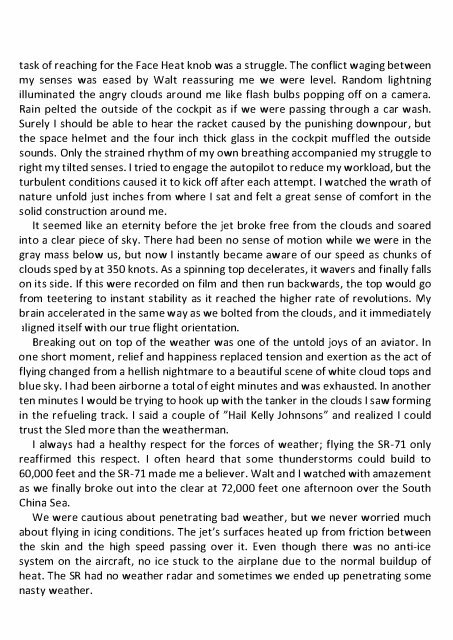Create successful ePaper yourself
Turn your PDF publications into a flip-book with our unique Google optimized e-Paper software.
task of reaching for the Face Heat knob was a struggle. The conflict waging between<br />
my senses was eased by Walt reassuring me we were level. Random lightning<br />
illuminated the angry clouds around me like flash bulbs popping off on a camera.<br />
Rain pelted the outside of the cockpit as if we were passing through a car wash.<br />
Surely I should be able to hear the racket caused by the punishing downpour, but<br />
the space helmet and the four inch thick glass in the cockpit muffled the outside<br />
sounds. Only the strained rhythm of my own breathing accompanied my struggle to<br />
right my tilted senses. I tried to engage the autopilot to reduce my workload, but the<br />
turbulent conditions caused it to kick off after each attempt. I watched the wrath of<br />
nature unfold just inches from where I sat and felt a great sense of comfort in the<br />
solid construction around me.<br />
It seemed like an eternity before the jet broke free from the clouds and soared<br />
into a clear piece of sky. There had been no sense of motion while we were in the<br />
gray mass below us, but now I instantly became aware of our speed as chunks of<br />
clouds sped by at 350 knots. As a spinning top decelerates, it wavers and finally falls<br />
on its side. If this were recorded on film and then run backwards, the top would go<br />
from teetering to instant stability as it reached the higher rate of revolutions. My<br />
brain accelerated in the same way as we bolted from the clouds, and it immediately<br />
3ligned itself with our true flight orientation.<br />
Breaking out on top of the weather was one of the untold joys of an aviator. In<br />
one short moment, relief and happiness replaced tension and exertion as the act of<br />
flying changed from a hellish nightmare to a beautiful scene of white cloud tops and<br />
blue sky. I had been airborne a total of eight minutes and was exhausted. In another<br />
ten minutes I would be trying to hook up with the tanker in the clouds I saw forming<br />
in the refueling track. I said a couple of "Hail Kelly Johnsons" and realized I could<br />
trust the <strong>Sled</strong> more than the weatherman.<br />
I always had a healthy respect for the forces of weather; flying the SR-71 only<br />
reaffirmed this respect. I often heard that some thunderstorms could build to<br />
60,000 feet and the SR-71 made me a believer. Walt and I watched with amazement<br />
as we finally broke out into the clear at 72,000 feet one afternoon over the South<br />
China Sea.<br />
We were cautious about penetrating bad weather, but we never worried much<br />
about flying in icing conditions. The jet's surfaces heated up from friction between<br />
the skin and the high speed passing over it. Even though there was no anti-ice<br />
system on the aircraft, no ice stuck to the airplane due to the normal buildup of<br />
heat. The SR had no weather radar and sometimes we ended up penetrating some<br />
nasty weather.


